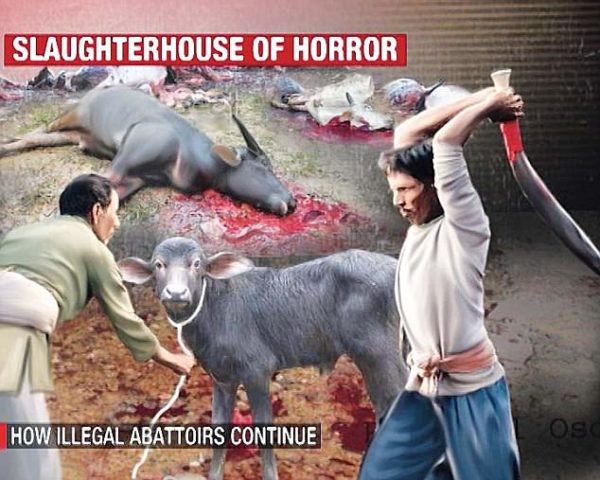WARNING GRAPHIC IMAGES
The animals and their offspring were killed in front of one another
Bleeding survivors trembled as sword-wielding butchers walked over carcasses to deliver a fatal blow
Al-Nasir Exports’ abattoir at Ghaziabad’s Dasna denied the allegations
Deserted and quiet during the day, a high-end meat factory near Delhi bursts into activity at night.
In the daytime, the sprawling Al-Nasir Exports’ abattoir at Ghaziabad’s Dasna appears to have been impacted heavily by the Yogi Adityanath government’s stringent regulation of the meat trade.
This buffalo slaughterhouse is also under the scanner for alleged construction violations. The Ghaziabad Development Authority has already raised several objections over its building plan and land use.
Potential penalties aside, the abattoir erupts into action when darkness descends. In the thick of night, this plush slaughterhouse turns into a house of horror where buffaloes and their little ones are literally put to the sword.
When India Today TV’s undercover team walked into its huge compound little after midnight recently, a horrendous sight unfolded on its secret cameras: hundreds of buffaloes, their babies lying on a blood-spattered floor, their throats slashed by primitive swords.
Conscious of their surroundings, the animals and their offspring were killed in front of one another in gross breach of anti-cruelty laws.
Bleeding survivors trembled as sword-wielding butchers walked over carcasses to deliver a fatal swipe. Calves tried to escape, but could not, pulled as they were by their legs and slashed at the neck.
The country’s anti-cruelty laws ban killing of pregnant or nursing animals and their babies less than three months in age. No animal is allowed to be slaughtered in sight of other animals in abattoirs either.
But India Today TV recorded extreme abuse at the Dasna slaughterhouse of Al-Nasir Exports, which on its website boasts itself as a global leader in frozen halal, buffalo meat.
The company also makes tall claims about compliance with international standards for slaughtering, bragging its quality controls. But the probe discovered severe contraventions at its abattoir.
Wrapped in plastic packaging, Al-Nasir’s meat products bear no resemblance to what our reporters found. An indescribable stench comes out of a thick, dark drain along the abattoir.
When reached for comment, Al-Nasir’s director Mohammad Salim Qureshi issued a flat denial of any wrongdoing.
‘We have all papers and licensing,’ he claimed. ‘Where do you procure such animals for slaughtering when there’s a ban on their sale?’ asked the reporter.
‘The new central law hasn’t been implemented fully yet,’ Quershi replied. ‘So far, it (slaughtering) is happening regularly.’
But abuse and environment degradation appeared to be a common practice in various animal businesses, big and small.
In the bushes of Amroha, India Today TV’s investigative reporters saw livestock crammed into a truck wagon for a hideous journey to one of the numerous, hole-in-the-wall slaughterhouses dotting UP.
The team visited a home turned into an abattoir for spot butchering and sale of buffalo meat. ‘You want meat. Get it from here. We’ll slaughter it and weigh it for you here itself,’ said Arif, its owner. ‘We’ll make it (slaughter) it for you at night. We’ll give you at Rs 140 a kilo.’
Soon, Arif untied a buffalo, pulled it outside of the house and on to a truck.
Chopped and skinned carcasses of buffaloes could also be seen at dilapidated meat shops in parts of Amroha.
‘What I have here are (meat of) five male buffaloes. I’ll get more animals from the market if our deal is finalised,’ said Amir, a meat seller.
‘It will be Rs 150 (per kg).’ In Agra, the reporters met Chand, a supplier of buffalo meat and a butcher himself. ‘Did slaughtering happen today?’ asked the journalist.
‘Yes, five-six buffaloes were slaughtered at our own home,’ Chand confessed. A middleman in meat business, Zaheer-ud-Din also guaranteed supplies of outlawed produce.
A resident of Agra’s Sadar Bazaar area, he disclosed how he would organise the delivery.
‘We will do it (the slaughtering) at home itself,’ he explained.







Leave a reply